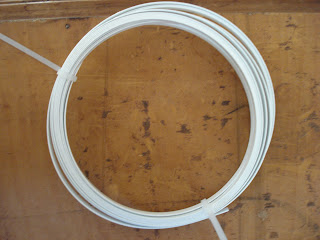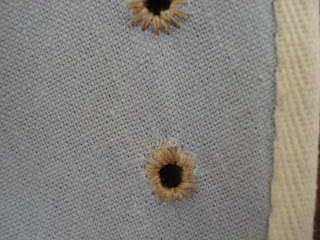Hello all,
I've finally moved into the new place and the dear hubby is back to work.. blowing things up.
I've been commisioned to make a fitted caraco jacket, stomacher and petticoat for a wonderful customer in the USA. She sent me the fabric, a fantastic printed cotton. Very period correct, beautiful. >>
At first, as always, washed the fabric in cold and dryed on hot. This prevents any shrinkage when the garment is washed. I've been many people spend hundreds of dollars on beautiful items only to have them shrink, stretch and pull after washing.

This garment is going to resemble one found on display at the V&A Museum. <<
Since the fabric is 45" wide using the usual method of petticoat construction would obviously not work, besides the directional nap. In this case I used three lengths. She wanted the petticoat to be 35" long. So I used 3 length 45" x 35". Because of the nap, I matched the pattern and hide the seams as best I could in them and the pleats. The front is unobstructed, there is one seam at each hip and one at the center back... very sneaky if I do say so myself.
I then pleated the waistband into the desired width and basted the pleats. When making a petticoat don't forget to leave a large box pleat at the front center and a smaller one at the back center. When the pleats were basted the pocket slits had to be sewn. Rule of thumb on an average size person is about 8" for the pocket slit. Because the slit wasn't on a seam as they usually are, I had to be very careful about stitching the bottom to re-enforce and prevent the fabric from tearing.
When the pocket slits are done, I used 1/2" cotton twill tape in a natural color (19" on either side + waist measurment) and whip stiched one side down. to prevent the twill from fraing, cutting a dove tail in the end really helps, and makes it look pretty. Even though using a whip stitch I ensured that my needle went through all layers of the pleats. This holds everything together. I then tacked the end firmly shut so when tying the petticoats nothing comes apart, then whipped stich the other side in place covering my previous stitches and basting thread. Now the waist band is completed.
If you have a dress dummy, use one! If not get the closest person in the room to help you. Either have them wear the petticoat and stand on a chair, or if you trust them with pins, wear the petticoat yourself and stand on a chair. Then you, or your helper can pin the bottom of the petticoat into a hem. To help get a strait bottom, meaure with a strait ruler a number of distance from the floor/chair to the edge of the skirt, if you have the same distance all the way around, you're good to go!
I usually sew this using a running stitch, but if yours are not small enough, use a whip stitch. Another really easy hemming idea that was very common in the 18th century, twill tape! This adds some weight to the bottom of the skirt to help it fall. It also recieves the brunt of the dirt and wear and tear. If you're limited in number of petticoats, its very easy to 'spruce' one up by replacing the worn twill tape with new tape - the difference is amazing! It can be sewn on with the same method as the waist band - with no pleats of course!
Thats all there is to a petticoat... pretty simple but time consuming. If you're going to machine sew, please hand sew the bottom hem. It's one of the few edges seen on a petticoat and really does add the authenticity of your outfit. WEAR MORE THAN ONE! Shilouette is absolutly everything. One year I was in L'bourg Cape Breton and saw a lone woman standing on a hill with the sun behind her, it would have been a beautiful photo, except the wind was blowing, she only had one petticoat on and you could plainly make out the shape of her calves and thighs. In 18th century woman had no shape below the waist, except the bell of their skirts.
More to come later on the remaing journy of the caraco!










